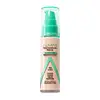What's inside
What's inside
 Key Ingredients
Key Ingredients

 Benefits
Benefits

 Concerns
Concerns

 Ingredients Side-by-side
Ingredients Side-by-side

Water
Skin ConditioningEthylhexyl Palmitate
EmollientPotassium Cetyl Phosphate
EmulsifyingGlyceryl Stearate Se
EmulsifyingGlycerin
HumectantButylene Glycol
HumectantCetyl Alcohol
EmollientMagnesium Aluminum Silicate
AbsorbentPhenoxyethanol
PreservativePolyacrylamide
C13-14 Isoparaffin
EmollientCaprylyl Glycol
EmollientChlorphenesin
AntimicrobialDisodium EDTA
Ethylhexylglycerin
Skin ConditioningNiacinamide
SmoothingPanthenol
Skin ConditioningTocopheryl Acetate
AntioxidantC9-11 Pareth-6
EmulsifyingQuartz
AbrasiveTocopherol
AntioxidantSodium Hyaluronate
HumectantKunzea Pomifera Fruit Powder
Skin ConditioningSyzygium Luehmannii Fruit Powder
AntioxidantTasmannia Lanceolata Fruit Extract
Skin ConditioningIsopropyl Alcohol
SolventCI 77891
Cosmetic ColorantCI 77492
Cosmetic ColorantCI 77491
Cosmetic ColorantCI 77499
Cosmetic ColorantWater, Ethylhexyl Palmitate, Potassium Cetyl Phosphate, Glyceryl Stearate Se, Glycerin, Butylene Glycol, Cetyl Alcohol, Magnesium Aluminum Silicate, Phenoxyethanol, Polyacrylamide, C13-14 Isoparaffin, Caprylyl Glycol, Chlorphenesin, Disodium EDTA, Ethylhexylglycerin, Niacinamide, Panthenol, Tocopheryl Acetate, C9-11 Pareth-6, Quartz, Tocopherol, Sodium Hyaluronate, Kunzea Pomifera Fruit Powder, Syzygium Luehmannii Fruit Powder, Tasmannia Lanceolata Fruit Extract, Isopropyl Alcohol, CI 77891, CI 77492, CI 77491, CI 77499
Water
Skin ConditioningCyclopentasiloxane
EmollientGlycerin
HumectantCyclohexasiloxane
EmollientNylon-12
Trimethylsiloxysilicate
EmollientPEG/PPG-18/18 Dimethicone
EmulsifyingDimethicone
EmollientCetyl PEG/PPG-10/1 Dimethicone
EmulsifyingBoron Nitride
AbsorbentIsodecyl Neopentanoate
EmollientCopernicia Cerifera Cera
EmollientSalicylic Acid
MaskingAloe Barbadensis Leaf Juice
Skin ConditioningMaris Sal
Skin ConditioningAlpha-Glucan Oligosaccharide
CleansingCaprylyl Glycol
EmollientDimethicone/Bis-Isobutyl PPG-20 Crosspolymer
EmollientHydrolyzed Vegetable Protein
Skin ConditioningLactobacillus
Skin ConditioningLecithin
EmollientMaltodextrin
AbsorbentPEG-10 Dimethicone
Skin ConditioningPerlite
AbsorbentPolymnia Sonchifolia Root Juice
Skin ConditioningTetrasodium EDTA
Tocopheryl Acetate
AntioxidantTriethoxycaprylylsilane
Trisiloxane
Skin ConditioningPhenoxyethanol
PreservativeIron Oxides
CI 77492
Cosmetic ColorantCI 77499
Cosmetic ColorantCI 77891
Cosmetic ColorantZinc Oxide
Cosmetic ColorantWater, Cyclopentasiloxane, Glycerin, Cyclohexasiloxane, Nylon-12, Trimethylsiloxysilicate, PEG/PPG-18/18 Dimethicone, Dimethicone, Cetyl PEG/PPG-10/1 Dimethicone, Boron Nitride, Isodecyl Neopentanoate, Copernicia Cerifera Cera, Salicylic Acid, Aloe Barbadensis Leaf Juice, Maris Sal, Alpha-Glucan Oligosaccharide, Caprylyl Glycol, Dimethicone/Bis-Isobutyl PPG-20 Crosspolymer, Hydrolyzed Vegetable Protein, Lactobacillus, Lecithin, Maltodextrin, PEG-10 Dimethicone, Perlite, Polymnia Sonchifolia Root Juice, Tetrasodium EDTA, Tocopheryl Acetate, Triethoxycaprylylsilane, Trisiloxane, Phenoxyethanol, Iron Oxides, CI 77492, CI 77499, CI 77891, Zinc Oxide
Ingredients Explained
These ingredients are found in both products.
Ingredients higher up in an ingredient list are typically present in a larger amount.
Caprylyl Glycol is a humectant and emollient, meaning it attracts and preserves moisture.
It is a common ingredient in many products, especially those designed to hydrate skin. The primary benefits are retaining moisture, skin softening, and promoting a healthy skin barrier.
Though Caprylyl Glycol is an alcohol derived from fatty acids, it is not the kind that can dry out skin.
This ingredient is also used as a preservative to extend the life of products. It has slight antimicrobial properties.
Learn more about Caprylyl GlycolCi 77492 is also hydrated iron III oxide. It's sole purpose is to give a yellow hue to products.
Iron III oxides are classified as inorganic chemicals for coloring.
Synthetically created Ci 77492 is considered safer than those naturally found. This is because the synthetically created version may contain less impurities. Iron oxides are generally non-toxic and non-allergenic.
Learn more about CI 77492Ci 77499 is also hydrated iron III oxide. It is created from mixing red and black iron oxides. This helps give shades of darkness to a product.
Iron III oxides are classified as inorganic chemicals for coloring.
Ci 77891 is a white pigment from Titanium dioxide. It is naturally found in minerals such as rutile and ilmenite.
It's main function is to add a white color to cosmetics. It can also be mixed with other colors to create different shades.
Ci 77891 is commonly found in sunscreens due to its ability to block UV rays.
Learn more about CI 77891Glycerin is already naturally found in your skin. It helps moisturize and protect your skin.
A study from 2016 found glycerin to be more effective as a humectant than AHAs and hyaluronic acid.
As a humectant, it helps the skin stay hydrated by pulling moisture to your skin. The low molecular weight of glycerin allows it to pull moisture into the deeper layers of your skin.
Hydrated skin improves your skin barrier; Your skin barrier helps protect against irritants and bacteria.
Glycerin has also been found to have antimicrobial and antiviral properties. Due to these properties, glycerin is often used in wound and burn treatments.
In cosmetics, glycerin is usually derived from plants such as soybean or palm. However, it can also be sourced from animals, such as tallow or animal fat.
This ingredient is organic, colorless, odorless, and non-toxic.
Glycerin is the name for this ingredient in American English. British English uses Glycerol/Glycerine.
Learn more about GlycerinPhenoxyethanol is a preservative that has germicide, antimicrobial, and aromatic properties. Studies show that phenoxyethanol can prevent microbial growth. By itself, it has a scent that is similar to that of a rose.
It's often used in formulations along with Caprylyl Glycol to preserve the shelf life of products.
Tocopheryl Acetate is AKA Vitamin E. It is an antioxidant and protects your skin from free radicals. Free radicals damage the skin by breaking down collagen.
One study found using Tocopheryl Acetate with Vitamin C decreased the number of sunburned cells.
Tocopheryl Acetate is commonly found in both skincare and dietary supplements.
Learn more about Tocopheryl AcetateWater. It's the most common cosmetic ingredient of all. You'll usually see it at the top of ingredient lists, meaning that it makes up the largest part of the product.
So why is it so popular? Water most often acts as a solvent - this means that it helps dissolve other ingredients into the formulation.
You'll also recognize water as that liquid we all need to stay alive. If you see this, drink a glass of water. Stay hydrated!
Learn more about Water